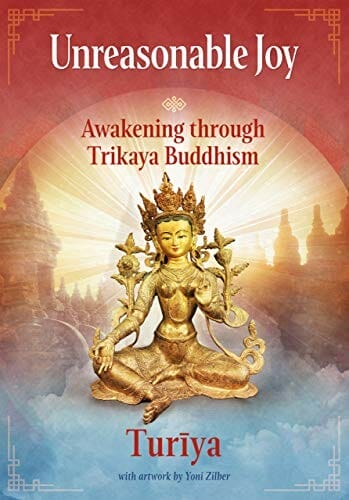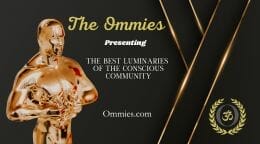Turiya: Awakening to Unreasonable Joy

Turiya is a Buddhist monk, teacher, and author who, despite living with chronic pain, founded the Dharma Center of Trikaya Buddhism in San Diego in 1998 to share her path. For over 25 years, she has taught thousands of students how to meditate, trained teachers, and helped people discover the unreasonable joy of our true nature. We sat down with her to talk about her life, her teachings, and her Spiritual journey and her new book, Unreasonable Joy.
An Interview with Turiya: Unreasonable Joy
OMTimes: It is an honor and pleasure to have you with us. Can you tell us how you started on the Buddhist Path? Was it a specific situation?

Turiya: When I was a child, I discovered sitting in silence felt good. Sitting alone was especially helpful in high school when the emotions are turbulent. Still, I had no name for it or even a solid technique. I would simply sit, sometimes with music and sometimes in silence, and let my mind relax. By then, I began searching for a spiritual path, but in a small New England town in the 1980s, my resources were limited. When I moved to San Francisco for college, a giant world of spirituality opened up. I searched, but nothing powerfully spoke to me, and I finally gave up. Then a college friend brought me to meet her teacher, Rama, and he shared a pathway to Enlightenment that was accessible. Although I learned about Buddhism in college, it was Rama who taught me the essence of Buddhism. I wrote about my encounters with him in my first book, Worlds of Power, Worlds of Light: Meeting an American Buddha.
OMTimes: How practical is it to integrate a stable Spiritual life into an ordinary day by day work routine? Do you have a set of self-disciplines or steps that might help with this Intention?
Turiya: There comes a time when we decide we have suffered enough. That’s when our spiritual life really begins. Once we’ve made this determination, making a commitment to practice is a no-brainer. So to integrate your spiritual life with your ordinary life, begin with motivation. Ask yourself what you hope to achieve by devoting hours to Meditation and attention to understanding how your mind works. Right now, you might not be interested in Enlightenment; perhaps you simply want more clarity and balance so you can be more present in your relationships or so you can be more effective at your job.
Start every meditation session with a reminder of your motivation and then carry that motivation throughout the day as you practice mindfulness. The daily seated Meditation is what allows us to practice mindfulness in the middle of our activities. To build a seated meditation practice, I often suggest students pair it with an activity they already do every day, like brushing their teeth. My favorite time to meditate is when I first get up, right after I feed the cats.
OMTimes: Would you say that Meditation is a common ground to all the Spiritual and Mystical Practices?
Turiya: Yes, from what I’ve explored, Meditation is a core practice in all spiritual traditions. Each one has its own method of silencing the mind, and in some religions, this knowledge seems to have been lost. But if we look past the words, the concept of Meditation is there. It’s when we stop our thoughts that we can see past our storylines and discover what is really here.
OMTimes: What is your formula for a Human Being (a Seeker) to develop a heart with no Judgement?
Turiya: The Path of Trikaya Buddhism I teach is very simple: pay attention. We always begin with ourselves. We ask: “What am I thinking?” “What am I feeling?” By paying attention to what is happening within our own being, we can act on the awareness gained. We naturally stop doing the things that hurt us and cause suffering, and we also become aware when we are caught in our habits and cannot stop. During this process, self-acceptance grows. Once we accept ourselves, with all our flaws and hang-ups, we become less judgmental. We waste less time and energy on beating ourselves up and put more effort into overcoming the habits that create suffering. When we have a clear view of what we struggle with in our own mind, we become more understanding and less judgmental of others. We recognize how, when others act out of fear or anger or hate, it’s because of the mind state they are trapped in. We can relate because we know what it’s like to be trapped.
OMTimes: The Zen Concept of Bearing Witness embraces joy and sorrow; it is to be one with the suffering we may encounter without Judgement. In doing such, we actively contribute to the healing of the situation inside of oneself. How does one conciliate action and non-action in the Practice to Bear Witness? How can Meditation enhance this approach?
Turiya: Becoming the Witness is a natural step on the Path. When we first learn Meditation, we’re really learning how to concentrate. Once we can concentrate on one point, our awareness opens up. We find ourselves in a state of watching. A sense of detachment grows as we see how different thoughts arise and fall away. As we carry this Witness consciousness into the World, we see how everything we experience appears and falls away. It’s like standing in the center of a hurricane, where the wind is completely calm, yet everything is swirling around us. When a situation triggers an attachment, we can watch the mind go through its mental gymnastics to create a story in which we are the hero or the victim. If we identify with the story, we fall back into the hurricane and start spinning. If we remain as the Witness, we can see what needs to be done, and we will see the opening to do it. We simply find ourselves acting.
An important distinction I want to make is being the Witness does not mean we go into denial. Some people touch upon the point of being centered. They strive for detachment, but what they are really doing is bypassing their own emotional and mental responses to a situation. They get frozen in place, and instead of working with the situation, there’s a shutting down that happens. Detachment grows at its own pace in the silence of Meditation and cannot be rushed.
As the Witness, we are fully aware of everything as it plays out within us. It can be painful as our attachments reveal themselves. We see what they cost us in terms of our relationships, our joy, and our peace of mind. We confront our present, and through it, we see our past and our potential future. A lot of fear typically comes up. But if we can stay the course, and keep paying attention through it all, then we eventually move beyond all sense of self, including the witness self.
OMTimes: Giving sequence to the last question; do you believe that the practice to “Bear Witness” is part of our “Spiritual Responsibility” as Humans Beings; and does it present elements of Spiritual Activism, in your opinion?
Turiya: “Spiritual Responsibility” sounds like a good way for the ego to co-opt the spiritual development process! When it comes to social activism, spiritual seekers need to be very careful. There is a tremendous draw to turn the attention outward and change the world to suit our temperament. This is what humans do, right? We encounter an environment, and we try to force it into an image of how we think it should be. If we follow the process to its end, and everything is how we want it, we discover there is still suffering. We know our body and all the work we have done will be washed away by time. What I teach, and what the Buddha taught, is not to get caught up in trying to change the world to fit our story of how we think it should be.
If we follow our spiritual Path and work our practice, we release the attachments causing strife and misery. Our awareness grows, and we act from our true nature, which is gentle, peaceful, and joyous. Everything we do is imbued with those qualities. In a natural and unforced way, our world changes in a beautiful way to reflect that.
As we live and work in the World, we can use the abrasiveness of it to sand down our ego and attachments. An example I give my students when teaching them about loving-kindness is holding the door for a stranger at the store. Kindness would be to hold the door and mentally grumble about how long it takes them to walk through. Loving-kindness is to hold the door patiently, giving your time and effort consciously to be of service to this person. When acting in this way, we become an example of what is possible through spiritual practice. And perhaps that will inspire someone to begin their own practice. If we are called to social activism, and some of my students are, then it’s important to allow that sense of service arise from our personal spiritual practice.
Continue to Page 2 of the Interview with Turiya
Creatrix from Sirius. Fairly Odd Mother of Saints (Bernards). Fish Tank aficionado by day ninja by night. Liane is also the Editor-in-Chief of OMTimes Magazine, Co-Founder of Humanity Healing International and Humanity Healing Network, and a Board Member of Saint Lazarus Relief Fund.










